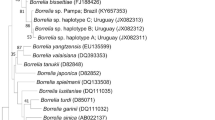Abstract
Chigger mites were collected from 1,080 wild birds of 37 species at Certak (Czech Republic), in the western Carpathian Mountains, from 29 July to 24 September 2005. The prevalence of infestation with chigger larvae was 7%. A total of 325 chigger specimens from 10 bird species was identified and three chigger species were found: Neotrombicula autumnalis, N. carpathica, and N. inopinata, the latter two species being reported on new hosts. Neotrombicula carpathica is reported in the Czech Republic for the first time. A total of 509 chigger larvae found on 79 host specimens were examined by polymerase chain reaction (PCR) for the presence of Borrelia burgdorferi s.l. DNA (fragments of the rrf (5S)—rrl (23S) intergenic spacer), and Anaplasma phagocytophilum DNA (epank1 gene). A fragment of specific Borrelia DNA was amplified through PCR in one sample, and the PCR product was further analyzed by reverse line blotting assay, whereby both genospecies of B. garinii and B. valaisiana were proved. This sample pooled five chigger larvae collected from one Sylvia atricapilla on 11 August 2005. No A. phagocytophilum DNA was amplified. We conclude that larvae of the genus Neotrombicula can be infected with Borrelia genospecies originated from their present or former hosts.
Similar content being viewed by others
References
Coignoul F (1976) Infestation par les Trombididae chez les carnivores domestiques. Ann Med Vet 120:549–550
Comstedt P, Bergstrom S, Olsen B et al (2006) Migratory passerine birds as reservoirs of Lyme borreliosis in Europe. Emerg Infect Dis 12:1087–1095
Daniel M, Pejcoch M, Kaluz S (1995) Acarina: Prostigmata (Trombiculidae). Folia Fac Scient Nat Univ Masarykianae Brunensis, Biol 92:71–74
Diza E, Papa A, Vezyri E et al (2004) Borrelia valaisiana in cerebrospinal fluid. Emerg Infect Dis 10:1692–1693
Fernandez-Soto P, Perez-Sanchez R, Encinas-Grandes A (2001) Molecular detection of Ehrlichia phagocytophila genogroup organisms in larvae of Neotrombicula autumnalis (Acari. Trombiculidae) captured in Spain. J Parasitol 87:1482–1483
Guy EC, Stanek G (1991) Detection of Borrelia burgdorferi in patients with Lyme disease by the polymerase chain-reaction. J Clin Pathol 44:610–611
Hanincova K, Taragelova V, Koci J et al (2003) Association of Borrelia garinii and B. valaisiana with songbirds in Slovakia. Appl Environ Microbiol 69:2825–2830
Kampen H, Scholer A, Metzen M et al (2004) Neotrombicula autumnalis (Acari, Trombiculidae) as a vector for Borrelia burgdorferi sensu lato? Exp Appl Acarol 33:93–102
Kudryashova NI (1998) Chigger mites (Acariformes, Trombiculidae) of East Paleartics (in Russian). KMK Scientific Press, Moscow
Kurtenbach K, Peacey M, Rijpkema SGT et al (1998) Differential transmission of the genospecies of Borrelia burgdorferi sensu lato by game birds and small rodents in England. Appl Environ Microbiol 64:1169–1174
Literak I, Honza M, Pinowska B et al (2001) Larvae of trombiculid mites (Acarina: Trombiculidae) in wild birds in Slovak and Polish Carpathians. Acta Vet Brno 70:479–483
Reeves WK, Dowling APG, Dasch GA (2006) Rickettsial agents from parasitic Dermanyssoidea (Acari: Mesostigmata). Exp Appl Acarol 38:181–188
Saito K, Ito T, Asashima N et al (2007) Borrelia valaisiana infection in a Japanese man associated with traveling to foreign countries. Am J Trop Med Hyg 77:1124–1127
Skoracki M, Michalik J, Skotarczak B et al (2006) First detection of Anaplasma phagocytophilum in quill mites (Acari: Syringophilidae) parasitizing passerine birds. Microbes Infect 8:303–307
Stekolnikov AA (1997) Geographical variability of the chigger species Neotrombicula autumnalis and its interrelationships with N. caucasica stat. nov. (Trombiculidae) (in Russian). Parazitologiya 31:397–413
Stekolnikov AA (2001) New species and sympatric relations of the chigger mite species group talmiensis (Trombiculidae, Neotrombicula) (in Russian). Parazitologiya 35:496–518
Strle F (2004) Human granulocytic ehrlichiosis in Europe. Int J Med Microbiol 293:S37, 27–35
Stekolnikov AA (2002) Variability of chigger mites of the N. talmiensis group, genus Neotrombicula Hirst, 1925, (Acari, Trombiculidae) in areas of sympatry in the Western Caucasus. Entomol Rev 82:1178–1189
Taragelova V, Koci J, Hanincova K et al (2008) Blackbirds and song thrushes constitute a key reservoir of Borrelia garinii, the causative agent of borreliosis in Central Europe. Appl Environ Microbiol 74:1289–1293
Walls JJ, Caturegli P, Bakken JS et al (2000) Improved sensitivity of PCR for diagnosis of human granulocytic ehrlichiosis using epank1 genes of Ehrlichia phagocytophila-group ehrlichiae. J Clin Microbiol 38:354–356
Wilske B, Busch U, Eiffert H et al (1996) Diversity of OspA and OspC among cerebrospinal fluid isolates of Borrelia burgdorferi sensu lato from patients with neuroborreliosis in Germany. Microbiol Immunol 184:195–201
Acknowledgements
This study was funded through grant No. MSM6215712402 from the Ministry of Education, Youth and Sports of the Czech Republic and Lenka Dubska received funding through grant No. 524-08-P139 from the Czech Science Foundation. We thank Dr. Miroslav Petrovec (Department of Infectious Diseases, University of Ljubljana, Slovenia) for providing A. phagocytophilum DNA, and Dr. Elena Kocianova (Institute of Virology, Bratislava, Slovakia) for a determination of ticks Ixodes ricinus. The authors declare that the study complies with the current laws of the Czech Republic.
Author information
Authors and Affiliations
Corresponding author
Rights and permissions
About this article
Cite this article
Literak, I., Stekolnikov, A.A., Sychra, O. et al. Larvae of chigger mites Neotrombicula spp. (Acari: Trombiculidae) exhibited Borrelia but no Anaplasma infections: a field study including birds from the Czech Carpathians as hosts of chiggers. Exp Appl Acarol 44, 307–314 (2008). https://doi.org/10.1007/s10493-008-9150-1
Received:
Accepted:
Published:
Issue Date:
DOI: https://doi.org/10.1007/s10493-008-9150-1




